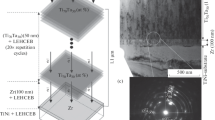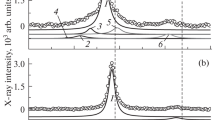Abstract
The mechanism of the solid-state amorphization has been investigated by means of the microstructural studies on the evolution of Ni/Zr diffusion couples, prepared at different sputtering pressures, during short heating times at high temperature. In the sample deposited at 8 mTorr compared to that at 3 mTorr, the possibility of the supersaturation sequence prior to amorphization is observed, and the amorphous phase grows extremely fast with diffuse interface. A high-resolution TEM image shows that the amorphous phase preferentially penetrates along the Zr grain boundary into the Zr layer and selectively grows from the grain boundary into the region of Zr grain with many defects. From the results, the importance of interstitial diffusion has been discussed, and a modified mechanism has been suggested.
Similar content being viewed by others
References
X.L. Yeh, K. Samwer, and W.L. Johnson, Appl. Phys. Lett. 42, 242 (1983).
R. B. Schwarz and W. L. Johnson, Phys. Rev. Lett. 51, 415 (1983).
K. Samwer, Phys. Rep. 161, 1 (1988).
W.L. Johnson, in Materials Interfaces, edited by D. Wolf and S. Yip (Chapman & Hall, New York, 1992).
A. M. Vredenberg, J. F. M. Westendorp, F. W. Saris, N. M. van der Pers, and Th. H. de Keijser, J. Mater. Res. 1, 774 (1986).
W.J. Meng, C.W. Nieh, E. Ma, B. Fultz, and W.L. Johnson, Mater. Sci. Eng. 97, 87 (1988).
N. Saunders and A. P. Miodownik, J. Mater. Res. 1, 38 (1986).
H. J. Fecht, P. Desre, and W. L. Johnson, Philos. Mag. 59, 577 (1989).
D.W. Hoffman and J. A. Thornton, J. Vac. Sci. Technol. 16, 134 (1979).
H. Hahn and R. S. Averback, Phys. Rev. B 37, 6533 (1988).
Y. T. Cheng, M. A. Nicolet, and W. L. Johnson, Appl. Phys. Lett. 47, 800 (1985).
W.J. Meng, C.W. Nieh, and W.L. Johnson, Appl. Phys. Lett. 51, 1693 (1987).
S.B. Newcomb and K.N. Tu, Appl. Phys. Lett. 48, 1436 (1986).
W.J. Meng, P.R. Okamoto, L.J. Thompson, B.K. Kestel, and L.E. Rehn, Appl. Phys. Lett. 53, 1820 (1988).
D. Wolf, P.R. Okamoto, S. Yip, J.F. Lutsko, and M. Kluge, J. Mater. Res. 5, 286 (1990).
W.J. Meng, P.R. Okamoto, L.J. Thompson, B.J. Kestel, and L.E. Rehn, Appl. Phys. Lett. 53, 1820 (1988).
Author information
Authors and Affiliations
Rights and permissions
About this article
Cite this article
Chang, SG., Lee, JY., Kim, GH. et al. A study on the mechanism of amorphous phase formation by interdiffusion in Ni/Zr multilayers. Journal of Materials Research 10, 1555–1560 (1995). https://doi.org/10.1557/JMR.1995.1555
Received:
Accepted:
Published:
Issue Date:
DOI: https://doi.org/10.1557/JMR.1995.1555




